Vintage Kitchen: Lamb Cakes

Lamb cake. It’s more than just another term of endearment for your sweetie-pie. It’s an Easter tradition from the old country. A custom that compels people to bake delicious cakes in the shape of a lamb, decorate it elaborately, and serve it at the family Easter celebration.
And I was not informed.

Despite growing up in a solidly Easter-celebrating family, I was never given the chance to partake in such confectionery delicacies.
And now here I am, raising my daughter in a household without lamb cakes like a sucker.
Well, I say that’s a travesty, and I say no more!
Though it’s only just getting started in our own household, the lamb cake tradition is at least a century old. It’s origins aren’t exactly clear, but it certainly has European roots—German, Polish, and Italian, to be specific. But ask around, and you’re sure to find people the world over willing to wax nostalgic about their mother’s/grandmother’s/aunt’s annual lamb cake, and the particular way they decorated it. Dig a little deeper, and they'll share their precious family photos.
More clear than the origin is the symbolism of the lamb as it relates to the holiday. The lamb represents both sacrifice and new life. Christian religions refer to Jesus as the “lamb of God,” making the idea of making this sheep-shaped cake a little...odd, perhaps, while also being a bit on-the-nose. But then, what traditions aren’t at least a little strange?
So when I came across a vintage lamb tin, I knew what I had to do.

The instruction booklet was yellowed and torn, but its design was so ridiculously quaint, I couldn’t help but be enamored. I imagined gathering my daughter into the kitchen, where she and I would bake an adorable cake without making a mess at all. We would pipe on delicious buttercream icing without making a mess at all, and precious family memories would be made, without making a mess at all.
It’s fun to dream big.

It’s not too late for me, and it’s certainly not too late for you. All you need is a lamb cake mold! There are contemporary models available, but where’s the fun in that? Check out your local estate sales—you’re liable to find one!
Vintage cake molds come in a few different materials and styles. Cast iron models certainly have their benefits, but they also come with a cast iron price tag. Aluminum is a much more affordable option. Depending on your make and model, your mold might come with various styles of latches to hold it shut while it bakes and avoid dripping.
So, you have your tin. You have your hopes and dreams. Now you need your recipe.
Getting started
Not all cakes are created equal when it comes to making them into adorable lamb shapes that will stand up unassisted and hold onto piped icing well. Baking is both an art and a science, and it’s important to consider your ultimate goal before you start.
Kenneth Jarosch of Jarosch Bakery in Chicago has been making the Easter treats in his bakery since 1959. He uses a yellow pound cake for the approximately 800 cakes he’ll bake this season, but, he said, “these days, some bakers are switching to a cream cake mix or a pudding cake mix.”
For the home baker, you can certainly use a box mix if you’d like. Frankly, if you’re going to get serious about icing the cake, I’m not going to fault you for cutting a corner or two on the cake itself. But having gone through many trials and almost as many errors in the week after getting my mitts on this mold, I would recommend staying away from extra-moist cakes like devil’s food. They lack density, and the moist outer layer can buckle under the weight of a heavy buttercream.
As far as store-bought mixes are concerned, I had great luck with bundt cake mixes, which are a bit more dense than the “extra-moist cakes,” but certainly not dry.
But I also had great success with a scratch-made cake, so let’s talk about that one. Because if you’re going to go vintage, you might as well go all-in. Turn-of-the-century bakers didn’t have box mixes, after all.
Baking
This not-quite-a-pound cake made my most successful lamb, and was so delicious I have no doubt I’ll make a less sheepish form of it in the near future.
What you’ll need: 3 cups of flour
1 tsp. baking powder
¼ tsp salt
2 cups of sugar
2 sticks of butter, softened
1 tsp. vanilla
5 eggs
1 cup of milk
The rest is easy.
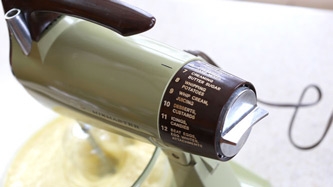
Preheat the oven to 350.
Sift together the flour, baking powder, and salt, and set aside.
In a separate bowl, cream the butter and sugar until fluffy.
Add the eggs and vanilla to the sugar and butter and blend for several minutes.
Alternately add in the flour and milk and mix until well-combined.
Pour batter into well-greased and floured mold, and bake for 1 hour and 15 minutes.
Lamb cake molds are two-sided. The easiest route might seem to be to bake cake on both sides, level them off, and “glue” them together with icing, that’s not how the mold works.
The idea is to fill one side of the pan, cover it with the other side, and the cake will rise to fill the mold.
But I must admit, when I attempted my first lamb cake, and took the lid off prematurely, spilling half-baked batter all over the counter, I was tempted to try the two-side method. But then determination set in. Bakers of all types have been doing this for years, so surely I can too.
Liberally grease and flour your cake pans. The flour is important. When I used only cooking spray, the cakes frequently stuck to the mold, leaving me with a mangled sheep that I had no choice but to eat all by myself while whipping up a new batter.
Life is hard.
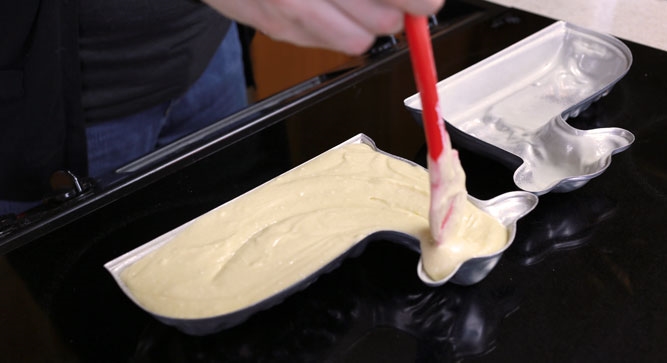
Fill the front of the mold completely, making sure the batter is spread evenly, particularly across the ears.
Depending on they type of batter you use, you might want to reinforce the cake. “Using our pound cake, we need to put toothpicks in the ears as we pour the batter in the molds to help prevent them from breaking off,” Jarosch said. “Some bakers who use a cream cake mix have had success without the toothpicks.”
For us, the boxed cakes required reinforcement. The pound cakes did not. But we’re working in a home kitchen, and those conditions may be different than your own home kitchen. So when you start out, you might consider reinforcing, just to be safe, rather than sorry.
Once the front half of your mold is full, place the other half on top, and set it in your preheated oven.
If this is your first attempt, I would strongly suggest placing the cake on a rack in the middle of the oven, with another rack below it. Place a cookie sheet or aluminum foil on the lower rack to catch any dripping batter.
Because there will be dripping batter.
If you’re using the recipe above, make sure to bake the cake for the full time before taking it out of the oven and lifting the lid. Test for doneness by inserting a toothpick in the middle of the cake. If it comes out clean, the cake is done. If it’s not fully cooked, at this point it should be safe to put it back in the oven without replacing the lid.
For our first box mix attempts, we opened the lid prematurely, and unwittingly released molten uncooked batter. If this happens to you, put the lid back on quickly and hope for the best, reminding yourself that it doesn’t need to be perfect, because it ultimately will all be covered in icing.
When all was said and done, we ended up cooking the box mixes for about 10 minutes longer than the instructions required. Your results may be different. Jarosch was surprised our cakes required that long of a bake time—his take only 35 minutes at 350 degrees, in a 24-pan revolving oven. "But you do what you gotta do," he said. Which I did. And so should you.
When your cake is complete, allow it to cool for 10 to 15 minutes without the lid before attempting to remove it from the mold. Don’t let it cool completely in the mold though or, like me, you’ll end up with a bit of a soggy crust that will stick to the pan and leave a bare spot on your cake (see below). Ultimately it will be covered, but it is still less than ideal.
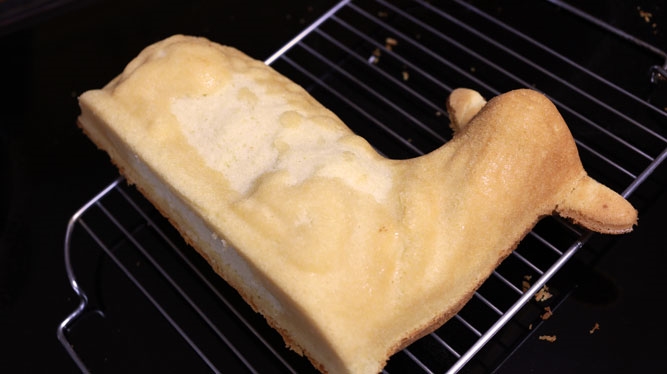
When the cake is cool, you can begin decorating.
Icing hides all
When it comes to decorating your lamb cake, your only limit is your imagination.
Jarosch says they feature three varieties in his bakery. “We dip our lamb heads in melted fondant icing (white donut icing) and pipe on buttercream ‘wool,’ or coat the body with buttercream and then cover it in coconut. Our third variety is covered entirely in chocolate fondant.” The 82-year-old German baker who works with Jarosch told him in Germany they are traditionally simply dusted with powdered sugar. The beauty of the mold, Jarosch said, is that you can see the details of the lamb's body, which makes a dusting of powdered sugar a lovely option. Bakeries in Polish neighborhoods, he said, make pastel-colored lamb cakes.
We made a few different styles, with different levels of success. Learn from our mistakes and our #cakefails. There were many of them. I was hesitate to share them (one in particular—you'll know it when you see it), because they're kind of ridiculous. But perhaps it will make you feel better about your own creations, if they aren't quite perfect.
But yours will be perfect. I'm sure of it.
Anyway, here are a few tips for making a lamb cake.
1) Always use a crumbcoat.
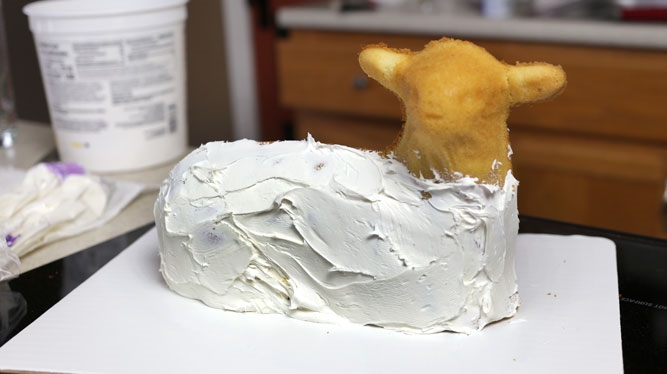
If you’re going to pipe icing onto a cake, you should cover the cake with a thin layer of icing first.
But I’m really going to glob on the icing when I pipe it, you might be thinking. The crumb coat will be overkill.
No. If you don’t use a crumb coat, your piping will fall off.
I mean, probably. Mine did.
And besides, icing is delicious. Why let an opportunity to use MORE icing pass you by?
2) Freeze your cake.
You don’t have to freeze it solid, but if you pop it in the freezer before you start piping, it will hold onto the icing better. Our kitchen was warm, as were my hands, which softened the icing quickly and thoroughly. The frozen cake and crumbcoat helped mitigate that issue.
3) Buy candy eyes.
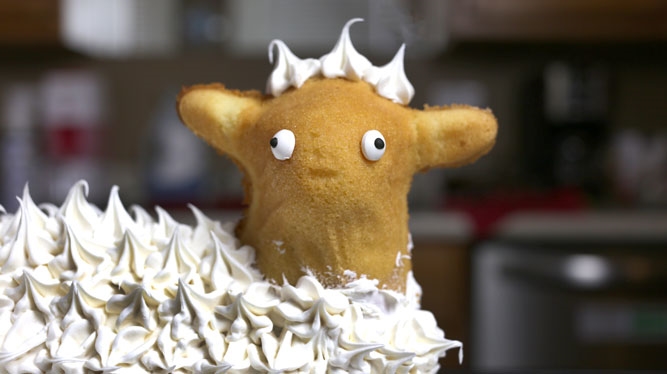
Your lamb will look like a Muppet.
"The eyes are the hardest part," Jarosch said. "We have always tried to make a respectful-looking lamb. They end up looking quite serious, almost reverent."
If you're confident in your piping skills, you might consider a more solemn sheep, but I was quickly becoming very aware of my limits. And besides, the Muppets are awesome.
4) Don’t overcook your ganache.
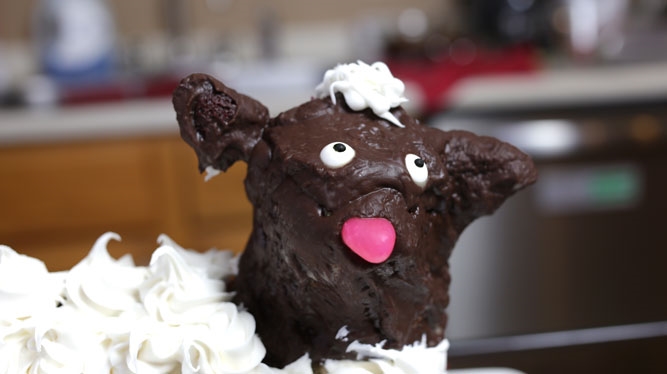
Icing may hide all, but ganache ain’t icing. If what you’re using isn’t smooth, it’s not going to end well. "Ganache can work," Jarosch said, "but. . .getting the right consistency is challenging, especially pouring over a cold lamb."
And avoid using chocolate chips to make your ganache, if you go that route, because not all chips were meant to be melted.
I know that now.
5) You will have extra batter. Don’t let it go to waste.
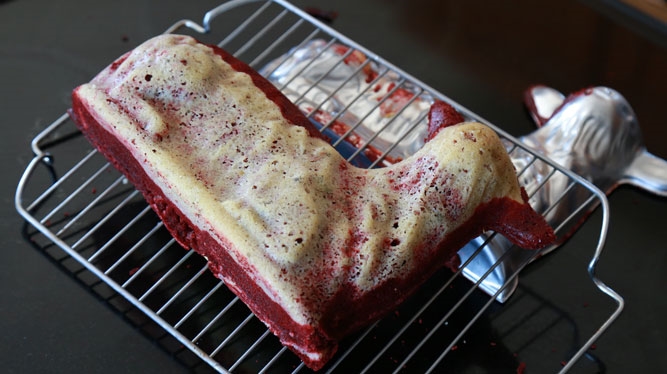
OK, I realize my red velvet / vanilla bean marble cake looks a bit...odd. I suppose I could have made cupcakes, but between the two batters there was exactly enough to make another lamb, and I knew I would need an entire herd for back up when I ultimately messed up while either baking or decorating its sheepish brethren. And once the cake was decorated, no one would know how...odd it looked on the inside.
And most importantly, this was probably the most delicious cake of the entire experiment, so I regret nothing.
6) Sometimes your sheep will look more like sheepdogs, and that’s okay too.

(Note to self: next time, make a marshmallow icing and cover the sheep with toasted coconut.)
7) Embrace the #cakefail.

Sometimes ears will fall off and you’ll toothpick them back in slightly askew. Sometimes your sheep will look a bit...mangey. Sometimes your sheep will look less like lambs and more like socially-awkward llamas.
Or maybe that’s just my experience.
But beneath that amateur piping job, and behind the cold, hard stare of those candy eyes is delicious cake. And isn’t that the most important thing?